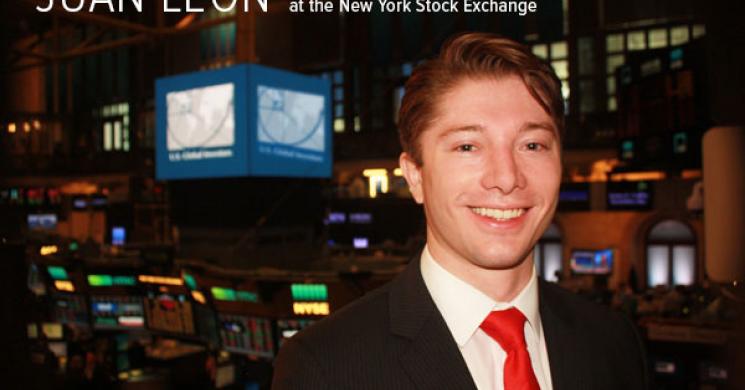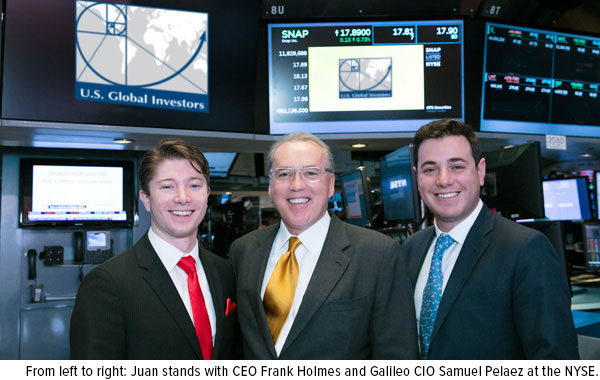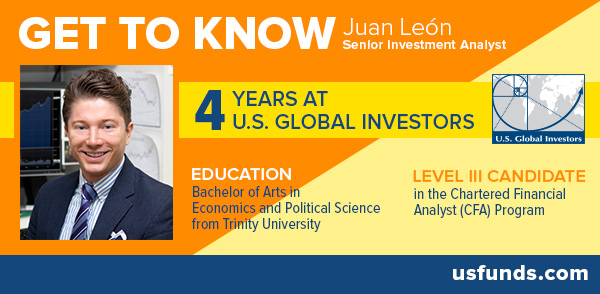
Meet Juan León – a key member of the U.S. Global Investors’ investment team. Juan is responsible for researching companies, sectors and industries, in addition to constructing new investment strategies for several of the firm’s mutual funds and ETFs. Juan joined the team in October 2014 and has since been promoted to senior investment analyst. In addition to focusing his research on domestic equities and the bond market, he also holds an interest in technology and often travels to conferences to learn from other professionals on how artificial intelligence (AI) is changing the business landscape.
In this brief Q&A you’ll learn more about Juan’s role and how he got into the investment business in San Antonio, after growing up in Ecuador and originally hailing from Colombia.
Tell us about your early career and why you chose the path of investments.
I grew up participating in Model United Nations and student government activities, so I went to college with the idea that I was going to work in diplomacy, international relations or politics. During my time at Trinity University, I participated in the student managed fund, which is a student-run investment fund that holds a portion of the university’s endowment. I did well in the program and discovered my aptitude and interest for investments and finance.
After graduation I went to work for Rackspace, a cloud computing company, which was great because I’ve always been interested in the technology sector. I worked in the finance department and had a good experience learning how companies work, how financial decisions are shaped and how you communicate with Wall Street on the finance and earnings side. After a few years I realized that I still wanted to explore a career in investing, so I came to work at U.S. Global Investors.
Describe your role as an investment analyst.
In my role I have the opportunity to tackle a variety of tasks and work with many of our funds, especially the two bond funds. I’m the main quant-focused member of our investment team and perform back testing, regressional and statistical analysis and help build our multi-factor investment models. I also help develop the quantamental strategies for our mutual funds and ETFs.
In terms of research, my main focus is on the bond market and domestic equities. The bond and equity markets are almost counterweights to one another. It’s helpful to keep a pulse on both to get insights that you wouldn’t necessarily have if you’re not thinking about both worlds.
How was the experience of ringing the closing bell at the New York Stock Exchange?
As someone working in the investment industry, ringing the bell at the New York Stock Exchange (NYSE) is a dream and not many professionals get to do that. On the day of the bell-ringing, they gave us a tour of the trading floor and the private rooms and I saw some great memorabilia. Once you get out there on the floor, there’s an intense, palpable energy with lots of people and lots of noise. Then when you ring the bell and you have everyone looking up and cheering you – it’s a great burst of energy.

What are your thoughts on where we are in the business cycle?
Right now I think we’re at a crossroads where we’re waiting to see how President Donald Trump’s protectionist policies and tariffs play out and whether or not it’s going to slow down economic growth. In the long-term, I think tariffs could lead to a slowdown in overall economic growth. In the short term, protectionist policies usually lead to insulated economies, which push up inflation because the cost of business and trade rises.
There’s also a great deal of concern by the investment public about the flattening of the yield curve. Historically, an inversion of the yield curve has been an accurate predictor of recessions. Although I do think we are in the late stages of the business cycle, I think the geopolitical concerns are driving volatility versus true economic slowdown. If you look at economic data in the U.S., it continues to move higher with robust consumer spending, manufacturing and services.
The longer end of the yield curve is up only 50 basis points, in terms of sigma or standard deviation moves. Just this week the longer end of the yield curve resumed moving up and we’re now again at 2.95 percent and approaching 3 percent. Compared to the shorter end, the longer end of the yield curve is less stretched in terms of sigma moves and has more room to run upwards before it hits an exhaustion point.

Want to learn more about domestic markets? Subscribe to the award-winning Investor Alert newsletter for a weekly recap of the biggest market-moving events.
----------------------------------------------
All opinions expressed and data provided are subject to change without notice. Some of these opinions may not be appropriate to every investor.
Standard deviation is a measure of the dispersion of a set of data from its mean. The more spread apart the data, the higher the deviation. Standard deviation is also known as historical volatility.
A basis point, or bp, is a common unit of measure for interest rates and other percentages in finance. One basis point is equal to 1/100th of 1%, or 0.01% (0.0001).
U.S. Global Investors, Inc. is an investment adviser registered with the Securities and Exchange Commission ("SEC"). This does not mean that we are sponsored, recommended, or approved by the SEC, or that our abilities or qualifications in any respect have been passed upon by the SEC or any officer of the SEC.
This commentary should not be considered a solicitation or offering of any investment product.
Certain materials in this commentary may contain dated information. The information provided was current at the time of publication.







